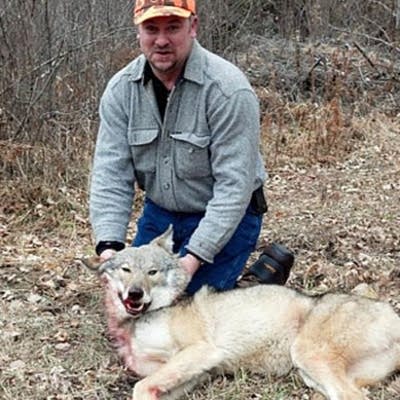Wolf hunt ends today; managment assessment begins
Go Deeper.
Create an account or log in to save stories.
Like this?
Thanks for liking this story! We have added it to a list of your favorite stories.

It's been just over a year since federal officials took the gray wolf off the endangered species list for the western Great Lakes region, prompting talk of a hunting season in Minnesota.
Court challenges and protests followed, including graphic billboards that asked Minnesotans to "Stop torture." Legislators approved the hunt and judges backed them.
Now, the state's first sanctioned wolf hunt is almost over, and Dan Stark, wolf specialist for the Department of Natural Resources, says, "I think for the most part the mechanics of it have worked pretty well."
Stark said there was just one hiccup at the end of the hunt: The state website and phone system that licensed wolf hunters are legally required to check regularly stopped working.
Turn Up Your Support
MPR News helps you turn down the noise and build shared understanding. Turn up your support for this public resource and keep trusted journalism accessible to all.
"I think it caused some confusion for hunters and trappers that were checking on the season status and the progress and be able to know whether they could legally hunt or trap," Stark said.

He said the DNR is not ready to say how things should change in future wolf hunts.
"I don't think we can really make any determination at this point until we do some further analysis and summarize what's occurred this year," Stark said. "We have a population survey that we're in the process of doing over the winter months, and we'll utilize that to make a proposal for next year."
Information from earlier in the season shows most wolves were killed in Itasca, Koochiching and St Louis counties, Stark said. The DNR closed hunting in northeast and east-central regions when quotas were reached in those areas.
By Wednesday afternoon, the kill count in the remaining open zone, the northwest, put the overall total just five wolves short of 400 killed.
Stark said the season could have lasted up until Jan. 31, but hunters hit the quota early partly because Minnesota has one of the highest wolf densities among states.

The early season ending did not surprise Ely resident Steven Voiles, who lives adjacent to a large hunting area. He says over time the wolves have become used to humans.
"To me that kind of made sense, because they've had 30 years of not having to be cautious," Voiles said.
Voiles did not support the wolf hunt, but said if another one takes place he hopes the DNR can focus the hunt more closely.
"I hope they direct their hunting to the areas that are more likely to cause problems instead of just territories where they are plentiful," Voiles said.
Blue Hill Township resident and longtime hunter Steven Hill supports the hunt, but did not participate in the wolf season. He thinks the DNR managed the hunt well, but both hunters and scientists will know more in the future.
"As people get more experience, they'll be more successful at it, all under the controlling, watchful eye of the biologists who know how the population has to be," Hill said.
The season ends a half hour after sunset today. Hunters can check their traps until 10 p.m.
• Follow Rupa Shenoy on Twitter: http://twitter.com/rupashenoy
Dear reader,
Political debates with family or friends can get heated. But what if there was a way to handle them better?
You can learn how to have civil political conversations with our new e-book!
Download our free e-book, Talking Sense: Have Hard Political Conversations, Better, and learn how to talk without the tension.







